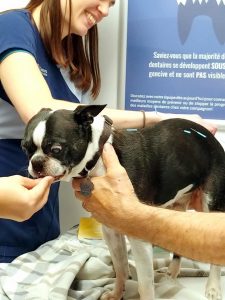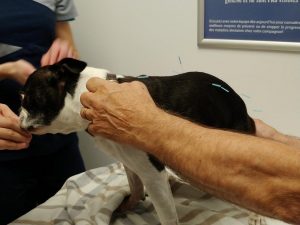Written by a CuraCore Veterinary Medical Acupuncture course graduate. Signed release obtained from client/author. 10S2019007
ABSTRACT
Yoda is 11 years old male Boston Terrier diagnosed in February 2019 with a disk disease located between T3-L3. He presented on October 22nd 2019 for his first acupuncture appointment with hind limbs ataxia, delayed conscious placement (CPs) and intermittent fecal incontinence. Yoda pursed a total of 5 acupuncture treatments along with laser therapy between October and November 2019, then continue a regiment of once a week treatment. After three treatments, he became more stable on his hind limbs and was able to walk without hurting his toes. However, between the fourth and fifth treatments, Yoda hurt himself while playing outside and the neurologic deficits resumed. Even if the neurologic deficits remained stable after this accident, owners continue acupuncture once a week to alleviate Yoda’s pain.
HISTORY AND CHIEF COMPLAINTS
Yoda is a 11 years old male Boston Terrier. He was first diagnosed with a discal hernia located between T3-L3 in February 2019 by a specialized surgeon in a reference center. Back then he was paretic and ataxic on both hind limbs, worst on the left. He was able to urinate normally but had intermittent fecal incontinence. Owners decided not to pursue in surgery and Yoda was treated with gabapentin, tramadol and prednisone, with small improvement. He went off his medication during the summer and began physiotherapy exercises including swimming, passive range of motion and had a total of 10 laser treatments with a class IV K-laser unit. No other treatment or medication was attempted between August and October 2019. He was first presented for acupuncture on October 22nd 2019. Owners have no other medical concern with Yoda.
PHYSICAL EXAMINATION AND CLINICAL ASSESSMENTS
Upon examination on October 22nd, Yoda is bright, alert and responsive. His body score is 5/9 and auscultation and abdominal palpation are normal. He presents a grade 2 medial patellar luxation on the right hind limb, bilateral nuclear sclerosis, symmetric testis and an hypertrophic prostate on anal digital palpation. His neurologic exam demonstrates delayed CPs on both hind limbs, worst on the left, rear limbs ataxia and delayed withdrawal reflex on the left rear. On myofascial exam, Yoda presents bilateral taut bands on infra and supraspinatus muscles as well as brachiocephalic muscles. Palpation of the back elicits thoracolumbar and lumbosacral pain and tenderness. A coat change is visible in the thoracolumbar area. The neck moves well in all directions.
PROBLEM LIST
– Hind limbs ataxia
– Delayed hind limbs CPs
– Delayed left rear withdrawal reflex
– Intermittent fecal incontinence
– Tenderness and pain in thoracolumbar and lumbosacral regions
– Grade 2 medial patellar luxation, right rear
– Hypertrophic prostate
DIFFERENTIAL DIAGNOSIS
Below a list of possible diagnosis that could explain Yoda’s neurologic deficits (ataxia, delayed CPs, delayed left rear withdrawal reflex intermittent fecal incontinence) and myofascial pain :
Vascular : vascular thrombus
Inflammatory/infectious : myelitis, discospondylitis
Neoplastic : spinal tumor, meningioma
Degenerative : Osteoarthritis, intervertebral disc disease, degenerative myelopathy
Iatrogenic/intoxication : benzodiazepine toxicity
Congenital : vertebral malformation
Autoimmune : autoimmune, meningoencephalomyelitis
Traumatic : vertebral fracture
Endocrine/metabolic : diabetes mellitus
PUTATIVE DIAGNOSIS
The most plausible diagnosis is intervertebral disc disease. It seems less likely that Yoda is suffering from an infectious/inflammatory or endocrine disease as he remained afebrile and there is no other systemic sign. As a neoplastic condition cannot completely be ruled out, the condition did not progress over the past year, which makes it less likely.
MEDICAL DECISION MAKING
As Yoda presents with neurologic deficits in both hind limbs, his acupuncture treatment was aimed to stimulate the spinal nerve branches of the sciatic and femoral nerves. In this manner, points along the Bladder (BL) and Governor Vessel (GV) channels were used. Yoda also presents with fecal incontinence, so the second target of the treatment was to alleviate the pain in the back and help fecal function. As so, BL 27 was used as the back shu point for large intestine along with autonomic points such as Stomach (ST)36, BL 40 and Spleen (SP) 6. Finally, Yoda presents with myofascial tension along the neck and scapulas, which leads to point selection based on trigger points findings.
MEDICAL ACUPUNCTURE AND RELATED TECHNIQUES USED


FIRST TREATMENT 10/22/2019
POINTS SELECTED
Governor Vessel (GV) 14 : Autonomic point (parasympathetic), shoulder/neck pain, relaxation point, central point
GV 20 : Relaxation point
Bai hui : Autonomic point (parasympathetic), lumbosacral pain, central point.
Gallbladder (GB) 21 : Peripheral point, trigger point, shoulder/neck pain
GB 30 : Peripheral point, sciatic nerve stimulation.
Bladder (BL) 21, BL23 : Central point, thora-columbar pain.
BL 27 : Central point, fecal incontinence
Bafeng: Peripheral point, neuronal stimulation.
Needles used : Seirin J 0,2x20mm : all points except GV 20, Bafeng
Seirin J 0,2x15mm : Bafeng + GV 20
SECOND TREATMENT 10/25/2019
POINTS SELECTED
Same points +
Stomach (ST) 36 : Autonomic point, fibular nerve stimulation, digestive function
BL25 : Central point, thoracolumbar pain.
Needles used : – Seirin J 0,2 X 30mm all points except Bafeng
– Seirin J 0,16 X 15mm for Bafeng
THIRD TREATMENT 10/28/2019
Yoda showed more tension in triceps/deltoids than the last time, less tension in the back and is more reactive to needling. No change in neu-rologic exam.
POINTS SELECTED
Same points than last treatment except GV 20 and Bafeng (too reactive) +
Small intestine (SI) 9 : Peripheral point, trigger point.
BL 60 : Peripheral point, tibial nerve stimula-tion.
Needles used : Seirin J 0,2X 30mm for all points

FOURTH TREATMENT
POINTS SELECTED
Same points +
Bafeng : Peripheral point, neuronal stimula-tion.
GB 31 : Peripheral point, sciatic nerve stimula-tion
Electro-acupuncture : BL18-BL25 bilaterally, continuous, 2mHz, 20 minutes with an ITO unit.
Needles used : – Carbo 0,2 X 30mm : BL18, BL 25
– Seirin J 0,2 X 30mm : GV 14, Bai Hui, GB 30, BL 23
– Seirin J 0,16 X 15 mm : ST 36, BL 60, BL 27
– Seirin J 0,14 X 15mm : Bafeng
FIFTH TREATMENT 11/08/2019
Yoda presented to his fifth treatment with im-portant tenderness in the back and shoulders, definitively worst than previous exam. Ataxia is worst than the previous exam. E-STIM was not elected because of his sensibility.
POINTS SELECTED/DRY NEEDLING :
GV 4, BL18, BL21, BL 23, BL 25 : Central points, thoracolumbar pain
Bai Hui : Central point, lumbo-sacral pain
BL40 : Autonomic point, tibial nerve
GV 14 : Central point, relaxation point, shoul-der/neck tension
SI 12 : Peripheral point, shoulder pain
GB 21 : Peripheral point, trigger point
SP 6 : Autonomic point, tibial nerve stimulati-on
BL60 : Peripheral point, tibial nerve stimulati-on
ST 36 : Autonomic point, digestive function, fibular nerve stimulation
GB 31, GB 30 : Peripheral points, sciatic ner-ve stimulation
Needles used : – Serin J 0,2 X 30mm : all points except BL 35, SP 6, GV 4, BL60, ST36
– Serin J 0,16 X 30mm : SP6, BL60, ST36
– Serin J 0,10 X 15mm : GV 4, BL35.
All acupuncture treatments were followed by laser therapy on thoracolumbar region and along both hind limbs with the K-Laser Unit, class IV, 826J applied on each area for 1:58 minutes.
OUTCOMES
Yoda demonstrates a great improvement within the first three treatments. He was able to walk without hurting his toes and was more stable on his hind limbs at rest. His left rear withdrawal reflex improved, but CPs were still delayed in both hind limbs. However, after the fourth treatment, Yoda hurt himself while playing outside. He presented to his fifth treatment with a lot more tension in the back, shoulders and neck than in the previous session and the neurologic deficits resumed. After this episode, we were not able to reach the same level of neurologic improvement with acu-puncture, so the ataxia and fecal incontinence persist. Although, owners found Yoda more playful and more stable on his hind limbs at rest as sessions went on and decided to continue with a regi-ment of once a week treatment to alleviate his pain.
DISCUSSION
As stated by the owners after the third treatment, acupuncture was the first of all treatments at-tempted that really made a difference in Yoda’s neurologic function. That corroborates the fact that even dogs with chronic clinical signs that were non responsive to previously administered medica-tion had improvement after electroacupuncture and standard medical treatment. This could be, in part, explained by the fact that acupuncture reduces the electrical resistance and enhances electrical activity of injured tissues. Therefore, acupuncture promotes healing and axonal regrowth. Howev-er, the fact that neurologic deficits resumed after Yoda’s fall demonstrates the fragility of those patients and the necessity for long term management. Electro-acupuncture was used only once be-cause of the reactivity of the patient, and at low frequency (2Hz). However, electroacupuncture at low frequencies produces endorphin release by the central nervous system whose effect can be blocked by naloxone, while high frequency electroacupuncture causes release of dynorphins . It would have been great, though, to perform electroacupuncture at 100Hz to see if the neuroprotec-tive effect of dynorphins would have cause more neurologic improvement. Yoda’s case is a great demonstration of how acupuncture can help alleviate the pain associated with intervertebral disk disease but also enlighten the importance of having realistic expectations when facing a patient with a year long history of neurologic impairment. The latter should be discussed well with clients pre-senting in veterinary clinic for acupuncture and alternative medicine.
REFERENCES
1. Hayashi, A.M and all, Evaluation of electroacupuncture treatment for thoracolumbar interverte-bral disk disease in dogs, JAVMA, 231(6):913-8 · October 2007
2. Dorsher, P.T. and McIntoch, P. M, Acupuncture’s effects in treating the sequelae of acute and chronic spinal cord injuries : A review of allopathic and Traditional Chinese Medicine literature, Evidence-based complementary and alternative medicine, 2011(1741-427X):428108
3. Taylor, Amanda R., Acupuncture for IVDD, Veterinary meeting and Expo 2018 proceedings, 2018.
4. Robinson, Narda, Non-surgical options for IVDD ? Keeping hope, and dogs, alive. Keeping hope for non surgical options remain for dogs to save more lives, Veterinary Practice News, May 23 2011.